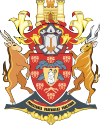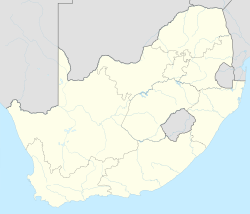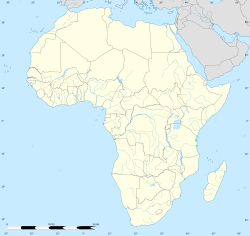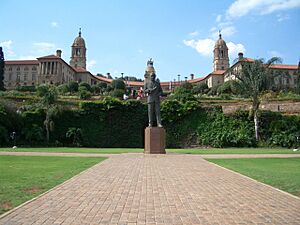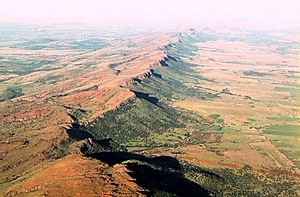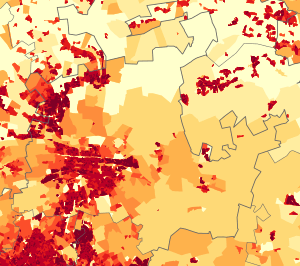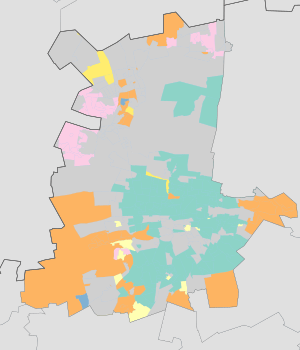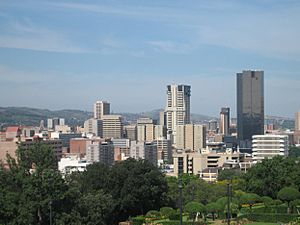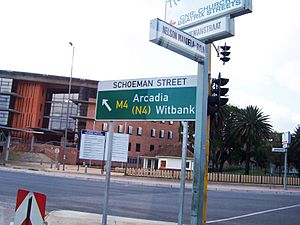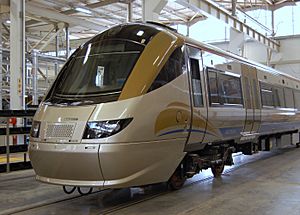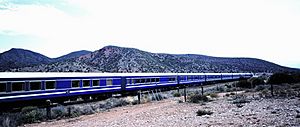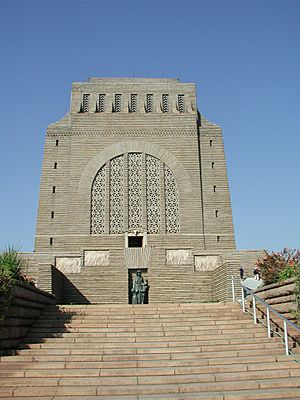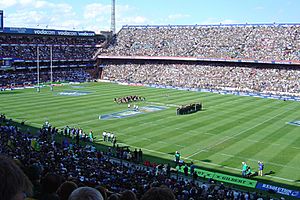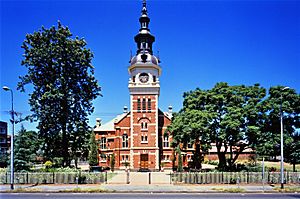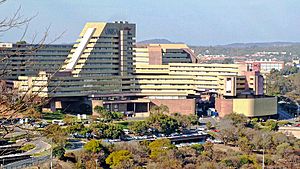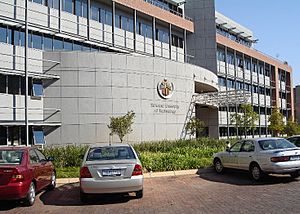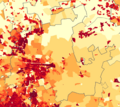Pretoria facts for kids
Quick facts for kids
Pretoria
Tshwane
|
|||
|---|---|---|---|
|
Pretoria viewed from the Voortrekker Monument
Union Buildings
Paul Kruger Statue
Palace of Justice
Ooskerk
Pretoria City Hall
Ou Raadsaal
|
|||
|
|||
| Nickname(s):
Jacaranda City
|
|||
| Motto(s):
Præstantia Prævaleat Prætoria (May Pretoria Be Pre-eminent In Excellence)
|
|||
| Country | |||
| Province | |||
| Municipality | City of Tshwane | ||
| Established | 18 November 1855 | ||
| Founded by | Marthinus Wessel Pretorius | ||
| Named for | Andries Pretorius | ||
| Government | |||
| • Type | Metropolitan municipality | ||
| Area | |||
| • Capital city (executive branch) | 687.54 km2 (265.46 sq mi) | ||
| • Metro | 6,297.83 km2 (2,431.61 sq mi) | ||
| Elevation | 1,339 m (4,393 ft) | ||
| Population
(2023)
|
|||
| • Capital city (executive branch) | 2,818,100 | ||
| • Density | 4,098.82/km2 (10,615.88/sq mi) | ||
| • Metro | 2,921,488 | ||
| • Metro density | 463.8880/km2 (1,201.4645/sq mi) | ||
| Racial makeup (2011) | |||
| • White | 52.45% | ||
| • Black African | 41.95% | ||
| • Coloured | 2.50% | ||
| • Indian/Asian | 1.93% | ||
| • Other | 1.17% | ||
| First languages (2011) | |||
| • Afrikaans | 47.67% | ||
| • English | 16.38% | ||
| • Sepedi | 8.02% | ||
| • Tswana | 5.44% | ||
| Time zone | UTC+2 (SAST) | ||
| Postal code (street) |
0002
|
||
| PO box |
0001
|
||
| Area code | 012 | ||
| HDI | |||
| GDP | US$ 75.6 billion | ||
| GDP per capita | US$ 23,108 | ||
| Website | tshwane.gov.za | ||
| Zulu | iPitoli |
|---|---|
| Xhosa | ePitoli |
| Afrikaans | Pretoria |
| Sepedi | Pretoria |
| Swazi | Pitoli |
| Sesotho | Pritoriya |
| Setswana | Tshwane |
| Xitsonga | Pitori |
| Venda | Pretoria |
Pretoria is one of South Africa's three capital cities. It is the administrative capital, meaning it's where the country's government leaders work. Many foreign countries also have their embassies here.
Pretoria is built along the Apies River and stretches towards the Magaliesberg mountains. It's known as a great place for learning and research. The city is home to important universities like the Tshwane University of Technology (TUT), the University of Pretoria (UP), and the University of South Africa (UNISA). It also has major research centers. Pretoria was even one of the host cities for the 2010 FIFA World Cup.
The city is part of a larger area called the City of Tshwane Metropolitan Municipality. This area includes other towns like Centurion and Soshanguve. There has been some talk about changing Pretoria's official name to Tshwane, which has caused a lot of discussion.
Pretoria got its name from a leader called Andries Pretorius. People in South Africa often call it the "Jacaranda City." This is because thousands of beautiful jacaranda trees bloom with purple flowers along its streets and in its parks.
Contents
- Pretoria's Past: A Look at History
- Pretoria's Location and Weather
- People of Pretoria: Demographics
- Pretoria's Look: Cityscape and Architecture
- Getting Around: Transportation in Pretoria
- Pretoria's Culture and Arts
- Education: Learning in Pretoria
- Military: Defence in Pretoria
- Proposed Name Change: Pretoria to Tshwane
- International Connections: Sister Cities
- Famous People from Pretoria
- Places to Visit in Pretoria
- Images for kids
- See also
Pretoria's Past: A Look at History
Pretoria was started in 1855 by Marthinus Pretorius. He was a leader of the Voortrekkers, who were early Dutch-speaking settlers. He named the city after his father, Andries Pretorius. He chose a spot by the Apies rivier (which means "Monkeys river" in Afrikaans). This place became the new capital of the South African Republic.
Andries Pretorius was a hero to the Voortrekkers. He won an important battle against the Zulus in 1838, called the Battle of Blood River. He also helped make a deal, the Sand River Convention (1852), where the United Kingdom agreed that the Transvaal was independent. Pretoria officially became the capital of the South African Republic on May 1, 1860. Starting Pretoria as the capital marked the end of the Voortrekkers' long journey, known as the Great Trek.
The Boer Wars: Conflicts and Peace
During the First Boer War, the city was surrounded by Republican forces in 1880 and 1881. The peace treaty that ended this war was signed in Pretoria on August 3, 1881. This agreement was called the Pretoria Convention.
The Second Boer War followed, which led to the end of the Transvaal Republic. The city surrendered to British forces on June 5, 1900. The war officially ended in Pretoria when the Peace of Vereeniging was signed on May 31, 1902, at Melrose House.
Before the Second Boer War, the Pretoria Forts were built to defend the city. Some of these forts are now ruins, but many are kept as important national monuments.
Becoming a Union: South Africa's New Era
In 1910, the Boer Republics joined with the Cape Colony and Natal Colony. They formed the Union of South Africa. Pretoria became the administrative capital for the whole country. Cape Town became the capital for making laws, and Bloemfontein for legal matters. From 1910 to 1994, Pretoria was also the capital of the Transvaal Province. On October 14, 1931, Pretoria officially became a city. When South Africa became a republic in 1961, Pretoria remained its administrative capital.
Pretoria's Location and Weather
Pretoria is about 56 kilometers (35 miles) north-northeast of Johannesburg. It's in the northeast of South Africa. The city sits in a valley, surrounded by the hills of the Magaliesberg range. It is about 1,339 meters (4,393 feet) above sea level. This valley location helps keep it warm and protected.
Pretoria's Climate: Warm Summers, Mild Winters
Pretoria has a humid subtropical climate. This means it has long, hot, and rainy summers. Winters are short, dry, and mild. The city usually has clear, cold nights in winter, but the days are pleasant. Night temperatures can sometimes drop to 2 to -5 degrees Celsius (36 to 23 degrees Fahrenheit).
The average yearly temperature is 18.7 degrees Celsius (65.7 degrees Fahrenheit). This is quite warm for its height above sea level. The valley acts like a heat trap, keeping the city warmer.
Most of the rain falls in the summer months. Winters are usually dry, and frost can be sharp. Snow is very rare in Pretoria. Snowflakes were seen in 1959, 1968, and 2012, but it has never snowed enough to cover the ground.
In November 2011, a heat wave brought temperatures up to 39 degrees Celsius (102 degrees Fahrenheit). This was very unusual for that time of year. In January 2013, temperatures went above 37 degrees Celsius (99 degrees Fahrenheit) for several days. 2014 was one of the wettest years, with 914 mm (36 inches) of rain. In 2015, Pretoria had its worst drought since 1982. November 2015 set new heat records, reaching 43 degrees Celsius (109 degrees Fahrenheit). On January 7, 2016, Pretoria hit a new record high of 42.7 degrees Celsius (108.9 degrees Fahrenheit).
People of Pretoria: Demographics
The number of people living in Pretoria can range from 700,000 to 2.95 million, depending on how the city area is defined. The main languages spoken here are Sepedi, Setswana, Xitsonga, Afrikaans, and English. Pretoria has the largest white population in Sub-Saharan Africa. It has always been a major center for Afrikaners, with about 1 million living in or near the city.
Different Ethnic Groups in Pretoria
Even after the end of Apartheid, Pretoria itself has mostly a white population. However, there is a growing black middle class. In the townships like Mamelodi, Soshanguve, and Atteridgeville, almost everyone is black. The largest white group is the Afrikaners, and the largest black group is the Northern Sothos.
If you only count the older, mostly white areas, then white people are the majority. But if you include the separate townships, Pretoria's population goes over a million, and white people become a minority.
In 1958, Indians were told to move from Pretoria to Laudium.
| Ethnic group | 2001 population | 2001 (%) | 2011 population | 2011 (%) |
|---|---|---|---|---|
| White | 355,631 | 67.7% | 389,022 | 52.5% |
| Black African | 128,791 | 24.5% | 311,149 | 42.0% |
| Coloured | 32,727 | 6.2% | 18,514 | 2.5% |
| Indian or Asian | 8,238 | 1.6% | 14,298 | 1.9% |
| Other | – | – | 8,667 | 1.2% |
| Total | 525,387 | 100% | 741,651 | 100% |
Pretoria's Look: Cityscape and Architecture
Pretoria is famous as the "Jacaranda City." This is because about 50,000 Jacaranda trees line its streets. Their purple flowers make the city look beautiful every October. The color purple is often linked to Pretoria. You can see it in local council logos and on the A Re Yeng bus system.
Buildings and Styles: Pretoria's Architecture
Pretoria's buildings show many different cultural influences over the years. You can see 19th-century Dutch, German, and British styles. There are also modern, postmodern, and art deco buildings. Many buildings also show a unique South African style.
Some famous buildings include the Palace of Justice from the late 1800s. The Union Buildings are from the early 1900s. The Voortrekker Monument was built after World War II. You can also see traditional Cape Dutch style at Mahlamba Ndlopfu, the President's House. The Old Synagogue has a Neo-Byzantine style. Modern buildings include the Reserve Bank of South Africa and the Telkom Lukasrand Tower. Other well-known places are the Loftus Versfeld Stadium and the South African State Theatre.
Downtown Pretoria: The Central Business District
Even though many businesses are in Pretoria's suburbs, the city center is still the main hub for government and business. Many banks, large companies, and shops are in the city center. It has several tall skyscrapers. The tallest are the Poyntons Building (110 meters/361 feet), the ABSA Building (132 meters/433 feet), and the Reserve Bank of South Africa building (150 meters/492 feet).
This area has many historical buildings, monuments, and museums. These include the Pretoria City Hall, the National Library of South Africa, and Church Square. You can also find the Transvaal Museum, which is a leading natural history museum. The National Zoological Gardens of South Africa (Pretoria Zoo) is here too. Other places are Melrose House Museum, the Pretoria Art Museum, and the African Window Cultural History Museum.
Many government departments have their main offices in the city center. These include Health, Education, Transport, and Justice. The district also has many homes for people who work there.
Green Spaces: Parks and Gardens
Pretoria is home to the National Zoological Gardens of South Africa and the Pretoria National Botanical Garden. There are also many smaller parks throughout the city. These include the Austin Roberts Bird Sanctuary and Pretorius Square gardens. Other popular spots are Church Square, Freedom Park, and Burgers Park, which is the oldest park in the city. In the suburbs, you can find Rietondale Park and Magnolia Dell Park.
The Jacaranda City: A Purple Wonderland
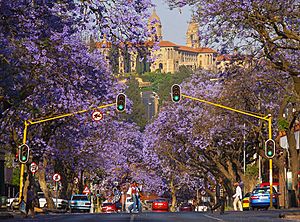
Pretoria is called "the Jacaranda City" because of its 70,000 jacaranda trees. They make the city look purple when they bloom in October. The first two trees were planted in 1888 by a gardener named J.D. Cilliers. He got the seedlings from Brazil. These two original trees are still at Sunnyside Primary School.
Jacaranda trees come from tropical South America. There are about fifty types, but the one most common in South Africa is the Jacaranda mimosifolia.
In the late 1800s, a flower grower named James Clark brought jacaranda seedlings from Australia. He started growing them in large numbers. In 1906, he gave 200 young trees to the Pretoria City Council. The city engineer, Walton Jameson, started a program to plant jacaranda trees everywhere. By 1971, there were 55,000 trees in the city.
Most jacarandas in Pretoria are lilac (light purple). But there are also white ones planted on Herbert Baker Street in Groenkloof.
The Jacaranda Carnival was a fun tradition held from 1939 to 1964. It started again in 1985. The celebrations include a colorful parade and the crowning of the Jacaranda Queen.
Getting Around: Transportation in Pretoria
Trains: Rail Services
Commuter rail services in Pretoria are run by Metrorail. These trains connect the city center to areas like Johannesburg in the south, Atteridgeville in the west, and Soshanguve in the north. You can also reach the port of Maputo in the east via the Pretoria–Maputo railway.
The Gautrain is a high-speed train line. It runs from the eastern suburb of Hatfield to Pretoria Station. From there, it goes south to Centurion and all the way to Johannesburg.
Pretoria Station is also where the luxurious Blue Train starts its journeys. Another luxury train service, Rovos Rail, operates from Capital Park.
Buses: Public Transport
Several bus companies serve Pretoria. PUTCO is one of the oldest and most well-known. The Tshwane municipality also provides bus services for the city.
Roads: Driving in Pretoria
The N1 is a major highway that goes through Pretoria. It comes into the city from the south. The N1 then turns north-east, bypassing the eastern suburbs. It helps traffic go from Johannesburg to Polokwane and the north. The N1 is a toll road, meaning you pay to use it. The R101 is the older version of the N1 and goes through the city center.
The N4 highway comes from eMalahleni in the east. It joins the N1 at an interchange. It then starts again north of the city, heading west towards Rustenburg. The N4 connects Maputo to Gaborone across South Africa. This is also a toll road.
There are other important roads like the N14, which heads south-west towards Krugersdorp. The R21 is another highway that goes south-east from Pretoria. It connects the city to OR Tambo International Airport. The R80 highway is in the north-west, linking Soshanguve to the city center.
Pretoria also has many regional roads and metropolitan routes to help people get around.
Airports: Flying In and Out
For regular flights, people in Pretoria use Johannesburg's airports. These are OR Tambo International Airport, about 45 km (28 miles) south, and Lanseria Airport, about 35 km (22 miles) south-west. Wonderboom Airport in northern Pretoria mainly handles smaller commercial and private planes. Since 2015, you can also take scheduled flights from Wonderboom Airport to Cape Town International Airport. There are two military air bases, Swartkop and Waterkloof, south of the city.
Pretoria's Culture and Arts
Media: News and Entertainment
Since Pretoria is part of the Tshwane Metropolitan Municipality, most radio, TV, and newspaper media are the same for the whole area.
Radio Stations
There are many radio stations in the Pretoria region:
- Jacaranda FM broadcasts in English and Afrikaans. It reaches Gauteng and other provinces, with 2 million listeners a week.
- Tuks FM is the radio station of the University of Pretoria. It's known for modern music and is run by students.
- Radio Pretoria is a community station for Afrikaners, broadcasting 24 hours a day.
- Impact Radio is a Christian Community Radio Station in Pretoria.
Television Channels
Pretoria receives channels like eTV, SABC, MNET, and SuperSport.
Newspapers
The city has several newspapers:
- Pretoria News is a daily English newspaper started in 1898. It covers the city and nearby areas.
- Beeld is an Afrikaans-language daily newspaper launched in 1974. It's distributed in four South African provinces.
Language: Pretoria Creole
Pretoria Sotho (called Sepitori by its speakers) is a common language spoken in Pretoria. It's a mix of Tswana and Northern Sotho (Pedi). It also has influences from other South African languages. This language developed in the city during the Apartheid years.
Museums: Exploring the Past
Pretoria has many museums where you can learn about history and culture:
- Ditsong National Museum of Cultural History, also known as African Window.
- Freedom Park, a place to remember South Africa's journey to freedom.
- Kruger House, the home of former president Paul Kruger.
- Melrose House, where the peace treaty ending the Anglo-Boer War was signed in 1902.
- Pretoria Art Museum, with a large collection of South African artworks.
- Transvaal Museum, a natural history museum.
- Voortrekker Monument, a large monument dedicated to the Great Trek.
Music: Sounds of Pretoria
Many popular South African bands and musicians come from Pretoria. These include Desmond and the Tutus, Bittereinder, The Black Cat Bones, and Seether. Famous rapper JR and DJ Mujava are also from here.
The song "Marching to Pretoria" is about this city. It was sung by British soldiers during the Second Boer War. They marched from the Cape Colony to Pretoria, which was the capital of the South African Republic. The song's chorus goes: "We are marching to Pretoria, Pretoria, Pretoria/We are marching to Pretoria, Pretoria, Hurrah."
Performing Arts and Galleries
Pretoria has a lot of public art, from sculptures to murals. The Pretoria Art Museum has a huge collection of local art. It focuses on South African artists like Henk Pierneef and Irma Stern.
Pretoria also has several places for performing arts:
A 9-meter (30-foot) tall statue of former president Nelson Mandela was put up in front of the Union Buildings in 2013. Since Mandela became president, the Union Buildings have become a symbol of the new 'Rainbow Nation'. Public art in Pretoria has grown a lot since the 2010 FIFA World Cup.
Sports: Rugby, Soccer, and Cricket
One of the most popular sports in Pretoria is rugby union. Loftus Versfeld is the home of the Blue Bulls rugby team. They play in the local Currie Cup and the international United Rugby Championship. The Bulls team won the Super Rugby competition in 2007, 2009, and 2010. Loftus Versfeld also hosts the football team Mamelodi Sundowns.
Pretoria hosted matches during the 1995 Rugby World Cup. Loftus Versfeld was also used for some games in the 2010 FIFA World Cup.
Association football (soccer) is very popular. Two teams from Pretoria play in South Africa's top league, the Premier Soccer League. These are Mamelodi Sundowns and Supersport United. Supersport United won the league in 2008–09. The University of Pretoria F.C. also played in the top league for a while.
Cricket is also a popular game. Pretoria doesn't have an international cricket stadium. However, nearby Centurion has Supersport Park, which hosts many big tournaments. The local cricket team is the Titans. Many cricketers from Pretoria have played for South Africa, including former captains AB de Villiers and Faf du Plessis.
The Pretoria Transnet Blind Cricket Club is the largest blind cricket club in South Africa.
Places of Worship
Most places of worship in Pretoria are Christian churches. These include the Zion Christian Church, Apostolic Faith Mission of South Africa, and Roman Catholic Archdiocese of Pretoria churches. There are also Muslim mosques and Hindu temples.
Jewish Community
Pretoria has a small Jewish community of about 3,000 people. Jewish citizens have been in Pretoria since it was founded in the 1800s. They helped the city grow. The first Jewish resident, Mr. De Vries, was an important citizen and a pioneer of the Afrikaans language. Another famous Jewish Pretorian was Sammy Marks.
Many early Jewish settlers came from Lithuania. They often worked as shopkeepers. Most Jewish residents stayed neutral during the Second Boer War.
The first Jewish congregation was formed around 1890-1895. In 1898, the first synagogue, The Old Synagogue, opened. A second synagogue, the Great Synagogue, opened in 1922. These are no longer in use. A Reformed synagogue, Temple Menorah, opened in the 1950s.
The Jewish community was very active in the early 1900s. Many Jewish sports clubs, charities, and youth groups were popular. After 1948, many Jews moved to Cape Town or Johannesburg.
The Old Synagogue was bought by the government in 1952. It became the High Court where important figures in the Anti-Apartheid Movement were tried. This included Nelson Mandela and others.
Two Jewish schools were started in Pretoria: Miriam Marks School (1905) and Carmel School (1959). Only Carmel School, which also serves as a synagogue, remains today.
Education: Learning in Pretoria
Pretoria is a top city for education in South Africa. It has the largest residential university and the largest distance learning university in the country. It also has a university focused on research.
High Schools
- Afrikaanse Hoër Meisieskool
- Afrikaanse Hoër Seunskool
- Christian Brothers' College
- Crawford College
- Deutsche Schule Pretoria (German school)
- École Miriam Makeba (French school)
- Hoërskool Menlopark
- Pretoria Boys High School
- Pretoria High School for Girls
- St. Alban's College
- St. Mary's Diocesan School for Girls
- Tshwane Muslim School
Universities: Higher Learning
University of South Africa (UNISA)
The University of South Africa (UNISA) was founded in 1873. It is the largest university in Africa. It teaches a third of all higher education students in South Africa. For much of its early history, it helped other universities get started. In 1946, it became a distance education university. In 2012, it had over 300,000 students from 130 countries. UNISA offers both job-focused and academic programs.
University of Pretoria (UP)
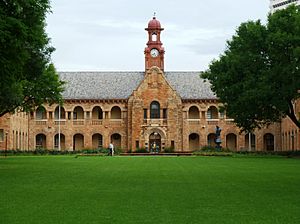
The University of Pretoria (also called UP, Tuks, or Tukkies) is a public research university with several campuses. It started in 1908 as the Pretoria campus of the Johannesburg-based Transvaal University College. It is the fourth oldest university in South Africa. Its Faculty of Veterinary Science, started in 1920, is the second oldest in Africa and the only one in South Africa. In 1949, the university started the first MBA program outside North America. Since 1997, UP has done more research than any other university in South Africa.
Tshwane University of Technology (TUT)
The Tshwane University of Technology (TUT) offers diplomas and degrees focused on careers. It was formed by joining three other colleges. TUT has about 60,000 students, making it the largest residential higher education institution in South Africa.
CSIR: Scientific Research
The Council for Scientific and Industrial Research (CSIR) is South Africa's main science and development organization. It was created by law in 1945 and has its own campus in the city. It is the largest research group in Africa. It has about 3,000 scientists and researchers.
Military: Defence in Pretoria
Pretoria is known as the center of South Africa's military. It has several important military facilities for the South African National Defence Force.
Military Headquarters
- Transito Air Force Headquarters: This is the main office for the South African Air Force.
- The Dequar Road Complex: This complex houses the headquarters for the South African Army, including the Infantry Formation.
- The Sebokeng Complex: This complex holds the headquarters for the Army Armour Formation, South African Army Artillery Formation, and other army intelligence and air defense groups.
Military Bases
- The Dequar Road Base: Located in Salvokop, it includes the headquarters for the Transvaalse Staatsartillerie (a reserve artillery regiment) and the Pretoria Armoured Regiment (a reserve tank regiment).
- Thaba Tshwane: A large military area south-west of Pretoria. It is home to several army units, including the Tshwane Regiment and the National Ceremonial Guard. It also has the 1 Military Hospital.
- Joint Support Base Wonderboom: Located next to Wonderboom Airport, this base is the headquarters for the South African Army Signals Formation.
Military Colleges
The South African Air Force College, the South African Military Health Service School, and the South African Army College are in the Thaba Tshwane Military Base. They train officers for different parts of the military. The South African Defence Intelligence College is also in the Sterrewag Suburb.
Air Force Bases
While not strictly inside Pretoria, Air Force Base Swartkop and Air Force Base Waterkloof are often used for military flights, transport, and VIP travel related to the city.
Proposed Name Change: Pretoria to Tshwane
On May 26, 2005, a council approved changing Pretoria's name to Tshwane. Tshwane is already the name of the larger municipality that includes Pretoria. However, the Minister of Arts and Culture did not approve the change and asked for more research. If the Minister approves it, the public will have a chance to comment.
Some groups have said they will go to court if the name is changed. The process is long, so a name change is not very likely.
The Tshwane Metro Council has been advertising "Africa's leading capital city" as Tshwane since 2005. This caused problems because the name had not officially changed. The Advertising Standards Authority (ASA) said these ads were misleading and should be stopped. Even after the ASA ruling, the council continued to use "Tshwane" in its ads.
In 2010, there were rumors again about the name change. This caused anger from some groups. It was later announced that the name "Tshwane" had been withdrawn from official publication. This was because the government decided that Pretoria and the municipality are separate.
As of 2023, the proposed name change has not happened.
International Connections: Sister Cities
Pretoria has "sister city" relationships with several cities around the world. This means they work together on cultural and other projects:
 Amman, Jordan
Amman, Jordan Baku, Azerbaijan
Baku, Azerbaijan Bucharest, Romania
Bucharest, Romania Bulawayo, Zimbabwe
Bulawayo, Zimbabwe Kumasi, Ghana
Kumasi, Ghana Kyiv, Ukraine
Kyiv, Ukraine Port Louis, Mauritius
Port Louis, Mauritius Taipei, Taiwan
Taipei, Taiwan Tehran, Iran
Tehran, Iran Washington, D.C., United States
Washington, D.C., United States
Famous People from Pretoria
- Anel Alexander, actress
- Melinda Bam, Miss South Africa 2011
- Sharlto Copley, actor
- Kurt Darren, singer/songwriter
- Damon Galgut, award-winning author
- Branden Grace, golfer
- Steve Hofmeyr, singer, songwriter and actor
- Glynis Johns, actress
- Anneline Kriel, Miss South Africa and Miss World 1974
- Paul Kruger, former president
- Michael Levitt, Nobel Prize winner
- Vusi Mahlasela, singer/songwriter
- Sammy Marks, entrepreneur
- Elon Musk, famous entrepreneur
- Kimbal Musk, entrepreneur
- Faf du Plessis, cricketer
- Austin Stevens, wildlife expert
- Arnold Vosloo, actor
- Casper de Vries, comedian
- Joost van der Westhuizen, rugby player
- A-Reece, rapper
- DJ Maphorisa, DJ and record producer
- Dricus du Plessis, MMA fighter
Places to Visit in Pretoria
- Pretoria National Botanical Garden: A garden with many local plants.
- The National Zoological Gardens of South Africa: South Africa's main zoo.
- Church Square: The historical government center of the South African Republic.
- Union Buildings: Where the South African government's executive branch works.
- Mahlamba Ndlopfu: The official home of the President of South Africa.
- Menlyn Park: A large shopping area.
- Voortrekker Monument: A historical site about the Great Trek.
- Hatfield Square: A popular area for students to relax.
- Pretoria railway station: A historical train station.
- Freedom Park: A historical site about the end of Apartheid and fallen soldiers.
- Pretoria Forts: Old forts built to protect the city, now a museum.
- State Theatre, South Africa: The main national performing arts center.
Nature Reserves: Exploring Wildlife
- Faerie Glen Nature Reserve
- Groenkloof Nature Reserve
- Rietvlei Nature Reserve
- Wonderboom Nature Reserve
Images for kids
-
A street lined with jacarandas in Pretoria, with the Union Buildings atop Meintjieskop in the background
See also
 In Spanish: Pretoria para niños
In Spanish: Pretoria para niños












